lucy
having dreams about rocks
 Becoming obsessed with rocks
Becoming obsessed with rocks
Member since June 2022
Posts: 52 
|
Post by lucy on Jul 24, 2022 16:42:12 GMT -5
Beautiful detail! Love these!
|
|
jamesp
Cave Dweller 
Member since October 2012
Posts: 36,602
|
Post by jamesp on Jul 24, 2022 18:39:13 GMT -5
Thanks  James Paul from Brisbane is excellent My type of teacher Clear concise information & fabulous sunset pictures!!! I personally wrote him just to thank him for those attributes He wrote back He seemed like a good fellow and proved it ! Ed, I learned on a fully manual 1957 twin reflex Rolleicord film camera at age 15. I have been able to shoot in manual mode fairly successfully ever since but every time I take the camera out I have to review all those settings every time. A new camera is a bit of a re-start, got to get to know it all over again. Most experienced photographers shoot regularly and stay dialed in. It is easy to forget the basic relationships between the settings. New cameras have thru-the-lense light meters which also help to get the photo exposed right. The Rolleicord had a slider that would allow you to select a shutter speed while also dragging the f-stop with it. Meaning if you switched the shutter speed from 1/125 to 1/60 the f-stop would change from f8 to f11. Or from 1/250 at f16 to 1/125 at f11. It did the 'calculation' for you. This taught the relationship between the shutter speed and the f-stop - faster shutter speed = larger aperture opening. Makes sense, the faster the shutter speed the bigger the hole needed to let more light hit the film. Small aperture openings like f11 and f16 give a deeper depth of field, bigger aperture openings like f2.8 or f3.6 give a shallower depth of field. Low light you probably need f2.8-f3.6-f5, with bright light you are fortunate and can use f11-f16-f22(for a deep depth of field). So this Lumix camera lens only goes down to f4.6 at full zoom, i.e. it is limited and requires strong sunlight. an expensive camera would have say an f2.8 lens, this Lumix is limited as it will only go down to f4.6. In other words, an f2.8 lens can take photos in much lower light conditions than a cheaper f4.6 lens. Lenses are rated by their lowest f-stop. An f2.8 lens is larger in diameter with big lenses to feed more light, a f4.6 lens is smaller and less costly. You start putting these relationships together and a camera starts to make sense. Here is a comparison, a 50mm f1.4 lens on left, and a 50mm f1.2 lens on right. The f1.2 is much more expensive. 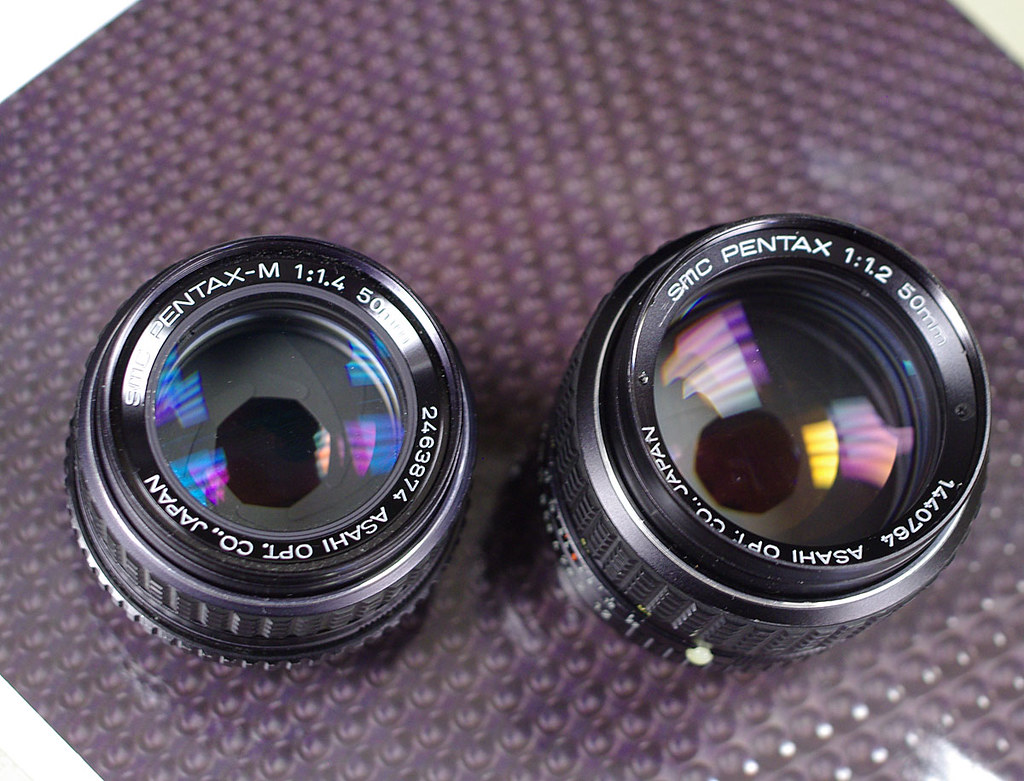 |
|
jamesp
Cave Dweller 
Member since October 2012
Posts: 36,602
|
Post by jamesp on Jul 24, 2022 18:41:11 GMT -5
Beautiful detail! Love these! Thanks Lucy. The camera made it easy. Had to whisper in their ears to keep them still ! |
|
|
|
Post by mohs on Jul 24, 2022 18:57:07 GMT -5
Right on That shutter speed to f-Stop ratio made lots of sense to me James Really good  can you explain what the 50 mm means? how did the aperture opening work in a mechanical camera was it dialed in by hand? |
|
jamesp
Cave Dweller 
Member since October 2012
Posts: 36,602
|
Post by jamesp on Jul 25, 2022 8:28:46 GMT -5
Right on That shutter speed to f-Stop ratio made lots of sense to me James Really good  can you explain what the 50 mm means? how did the aperture opening work in a mechanical camera was it dialed in by hand? Last question - yes, it was 100% mechanical. Because of that it was real real simple and made a mechanical sound when adjusting. Unlike the silence of a digital camera. You can see the shutter speeds at top of the dial, the f-stops at the lower section of the dial. As you rotated the dial the shutter speed synchronized with its appropriate f-stop for the given photo.(note the lens is a wicked fine Carl Zeiss) Note also this is a 'slow' camera, it is limited to f3.8 and a 1/500 shutter speed. Note also the simplicity, this old camera will take National Geographic level shots without 100 other digital settings. It has everything it needs to take great shots in good light within the limits of a 75mm focal length(general purpose) lens. This simple camera taught me to be able to tame a complicated digital camera. It is no different than a digital, it just does not have all those confusing OPTIONS, grrr.  50mm is the lens focal length(I believe it would be 50mm to focus to the film plate or the digital sensor plate). You can find the focal length of a common single lens magnifying glass by simply pulling it away from the subject, at the point it just starts to go out of focus that will be the distance of the focal length for that particular lens. It is simple. The 50mm is the focal length of that particular lense. The easy part - know that a 15mm to 35mm FL(macro) lens is good for macro. A 50mm FL is good for portraits and wider angle landscape shots. 100mm FL begins telephoto range and is very low power telescope. A 500mm(telephoto) has about the same magnification power as binoculars. A 1000mm FL(telephoto) is similar to a low power pay spotting scope like you would find in a National park. A 2000mm FL is really a telescope, it can see the rings on saturn. A 1000mm telephoto is always a physically long lens 15 to 50mm lens is short. The minimum focus distance to subject is short(inches) for a 15 to 35mm lens, and probably 10 feet away for a 1000mm lens. A 1000mm lens has a very narrow field of view, so it needs a lot of light(f1.4, f2.8, f3.6 in most conditions) A 15mm lens has a wide field(wide angle) of view and grabs a lot of light.(however the camera has to be so close to the subject that the camera often blocks the light to the subject ! Making macro shots tricky) Also the closer the camera gets to the subject the more easy it is to shake the camera and mess up the focus meaning a tripod is needed. This makes macro shots trickier to focus and get good light. So, I get dragonfly shots by using 500mm telephoto instead of a 15mm macro, this allows the camera to be 3 feet from the dragonfly and eliminates the need for the tripod because the camera is a whole 3 feet from the bug. Hope that helps Ed,. PS, it may behoove you to buy a 1950's model fully mechanical vintage camera from a junk shop just to see how it works. As soon as I put ANY camera in my hand my brain automatically reverts to the image of the old Rolleicord to remind me of shutter speed/f-stop(aperture) relationship. The Japanese copied the Rolleicord/Rolleiflex twin lens reflex. Mamiya made it but with a 105mm focal length. Same rotary dial shutter speed/f-stop selector design. It maxes out at f32 aperture and an long 8 second shutter speed. See shutter speeds 8-1-1/2-1/4-1/8-1/15 etc  |
|
lucy
having dreams about rocks
 Becoming obsessed with rocks
Becoming obsessed with rocks
Member since June 2022
Posts: 52 
|
Post by lucy on Jul 25, 2022 10:27:07 GMT -5
Had to whisper in their ears to keep them still !
You're the Dragonfly Whisperer! Keep it up!
|
|
|
|
Post by mohs on Jul 25, 2022 11:48:02 GMT -5
Interesting !
Had no idea that the mm rating
broke down that way
To the focal length
Really good explanation
Just a silly speculating question
What do you think Galileo telescope focal length was?
don’t thin those wops used millimeter math
or maybe they did?
divine geomancer
|
|
jamesp
Cave Dweller 
Member since October 2012
Posts: 36,602
|
Post by jamesp on Jul 25, 2022 13:49:24 GMT -5
Interesting ! Had no idea that the mm rating broke down that way To the focal length Really good explanation Just a silly speculating question What do you think Galileo telescope focal length was? don’t thin those wops used millimeter math or maybe they did? divine geomancer Not sure what Galileo used for units Ed. Who came up with the metric system ? It was probably close to the length of his telescope. Below is a 1000mm telescope with a 25mm focal length eyepiece. If memory serves, if you divide 1000 by 25 you get a 40 power telescope. If it was a 10mm focal length eyepiece you divide 1000 by 10 to get a 100 power telescope. If the focal length is 1000mm and the lense is 100mm in diameter(aperture) I believe it is considered an f10 telescope(1000/100 = 10). A 1000mm FL with a 200mm diameter lens is an f5(1000/200). The f5 will give bright images and the f10 not so bright with a given FL eyepiece(but the f10 would have twice the magnification). At 10 power the amount of light to the pupil is the surface area of the big lense divide by the surface area of the eye's pupil and then divided by 10. So the bigger the front lens the more light can be extracted.  Great telescope article, camera is similar to a telescope...: whichtelescope.com/index.htm |
|
jamesp
Cave Dweller 
Member since October 2012
Posts: 36,602
|
Post by jamesp on Jul 25, 2022 14:05:31 GMT -5
|
|
electrocutus
spending too much on rocks
 
Member since October 2020
Posts: 341 
|
Post by electrocutus on Jul 25, 2022 14:10:13 GMT -5
These are gorgeous pictures! Draonflies are such amazing insects. Thanks!
|
|
|
|
Post by mohs on Jul 25, 2022 14:30:06 GMT -5
Man James
Sure you’ve seen that program
w/Sir David Attenborough
using amazing photographic tricks
to tease out nature’s marvels
They have nothing on you!
|
|
jamesp
Cave Dweller 
Member since October 2012
Posts: 36,602
|
Post by jamesp on Jul 26, 2022 12:43:11 GMT -5
Man James Sure you’ve seen that program w/Sir David Attenborough using amazing photographic tricks to tease out nature’s marvels They have nothing on you! I wish I could hold a candle to such as him ! I will say that a nice DSLR with a 500mm telephoto would out do that Lumix by far. But a 500 is out of the budget. it is all about having the right lens for the job. wife has a older Nikon D7100 DSLR with an expensive 70-200mm lens. I'm not real familiar with it. I'll go try a few shots with it now and post. they can be compared to the Lumix. Just looking thru it here at table, it seems to magnify on 200MM setting more than the Lumix 500mm setting, hmmm. Smae minimum 3 foot focal distance from camera. Her lens is 'fast', an f2.8 as opposed to the Lumix f4.5. meaning I could shoot with much less light. Well, it is cloudy/sunny changing, I can try it in both light maybe...thinking cloud cover may eliminate color wash from glare. Who knows. |
|
jamesp
Cave Dweller 
Member since October 2012
Posts: 36,602
|
Post by jamesp on Jul 27, 2022 7:40:43 GMT -5
These were taken with the wife's expensive DSLR camera mohs. It has a 200mm lens compared to a 500mm on the Lumix so the photos had to be cropped over twice as much. If they were cropped more then the photo quality would suffer more so than the 500mm would(less crop). If the Lumix was set at 200mm the photo quality would probably be less in color reproduction and vividness. Maybe. The Lumix performs competitively though, impressive camera for the money. Plus it weighs about 1/4 of the wife's monster. The autofocus is far superior on wife's camera. In auto mode the Nikon picked about f6 at a 1/600 shutter and ISO 200. Not bad. If wanting to improve I would switch to Aperture priority to: f13 at a 1/200 shutter speed and ISO 100 or 200. The only benefit would be a wider focus depth so that the entire dragonfly was in focus. Nikon DSLR color is unbeatable:   The dragons are about maxed out, note distortion in closer up photo(1st photo). This was the best closer in photo by far. Difference between 200mm and 500mm  These are as good as it could perform from many shots taken.(I gave it my best). The Lumix does these easy thanks to 500mm.  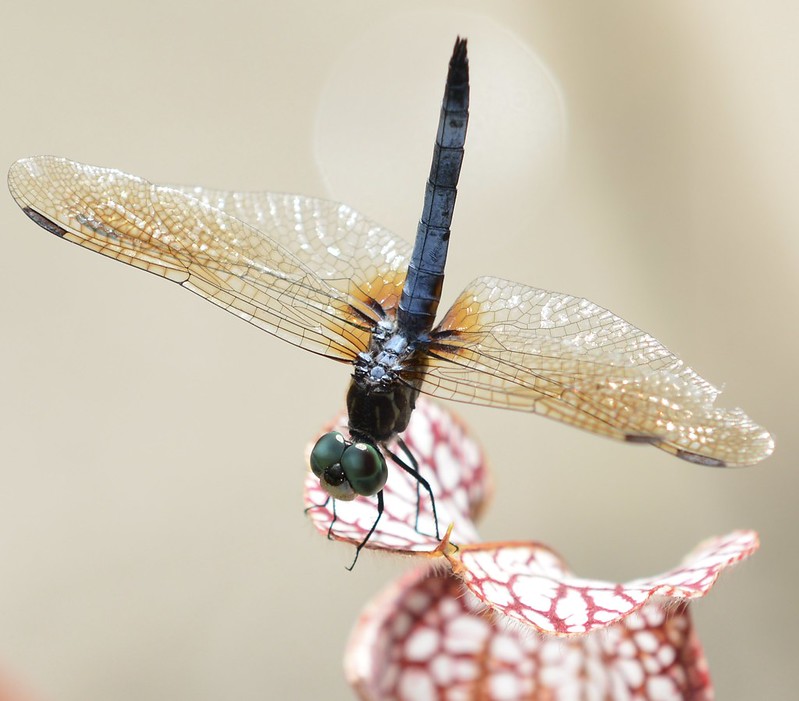  Note lack of sharpness due to heavy crop. This was the norm with 200mm.   With a good Nikon 500mm the outcome would have likely been dead sharp photos. I did spend 2 hours trying to figure out shooting in Nikon's aperture mode, kept running into wrestling with setting complications. Found out the ISO and white balance had to be manually set, then figure out how to change the aperture(instead of leaving the settings to 'AUTO' selected settings). Next time I will be able to shoot her camera in the more manual 'aperture mode'. Time well spent. And I had many years experience shooting with a Nikon DSLR(Nikon D90) years ago and the barrage of settings still were challenging to figure out. Let it be known that her newer D7100 was very similar to the older Nikon D90. A Canon DSLR(or any other brand) would have forced me to learn their settings, a big task. Best to pick a particular brand and stay with it since the settings would be repetitive. |
|
|
|
Post by mohs on Jul 27, 2022 9:39:12 GMT -5
mojo macro magic master,,,m  stly ! Is that a cricket wasp? |
|
|
|
Post by hummingbirdstones on Jul 27, 2022 10:12:38 GMT -5
Other varieties. The blue one is the dominator. They rule the area. Maybe someone knows why they stick there southbound end straight up in the air. Impaling parachuters ? My guess, and this is truly a guess, is that they're probably releasing pheromones to attract females or to mark territory. |
|
jamesp
Cave Dweller 
Member since October 2012
Posts: 36,602
|
Post by jamesp on Jul 27, 2022 12:56:12 GMT -5
Other varieties. The blue one is the dominator. They rule the area. Maybe someone knows why they stick there southbound end straight up in the air. Impaling parachuters ? My guess, and this is truly a guess, is that they're probably releasing pheromones to attract females or to mark territory. There is a good reason Robin. The pheromone concept sounds appropriate for these insects. Last year I was shooting them in late August early sept and never noticed that behavior once. They are more quarrelsome in July, noticed that. Dragons have distinct behavior related to mating and territory. Probably more territorial than any insect on earth. |
|
jamesp
Cave Dweller 
Member since October 2012
Posts: 36,602
|
Post by jamesp on Jul 27, 2022 13:05:13 GMT -5
mojo macro magic master,,,m  stly ! Is that a cricket wasp? That was the first time I captured a mud dauber Ed. Black with blue iridescence. They are hyper quick and don't sit still for photos ! They are a big nuisance because of all the available mud on the farm always plastering their mud nests on the most undesirable locations. They eat spiders by the 100's and have never stung me anyway. Great builders |
|
rob7789
off to a rocking start

Member since July 2022
Posts: 2
|
Post by rob7789 on Jul 28, 2022 21:55:51 GMT -5
Other varieties. The blue one is the dominator. They rule the area. Maybe someone knows why they stick there southbound end straight up in the air. Impaling parachuters ? It's called Obelisking. It's thought it is a way to regulate body temp. The Blue Dashers do that quite often. Nice shots! Nice variety: Slaty Skimmer, Eastern Amberwing, Blue Dasher and Widow Skimmer.  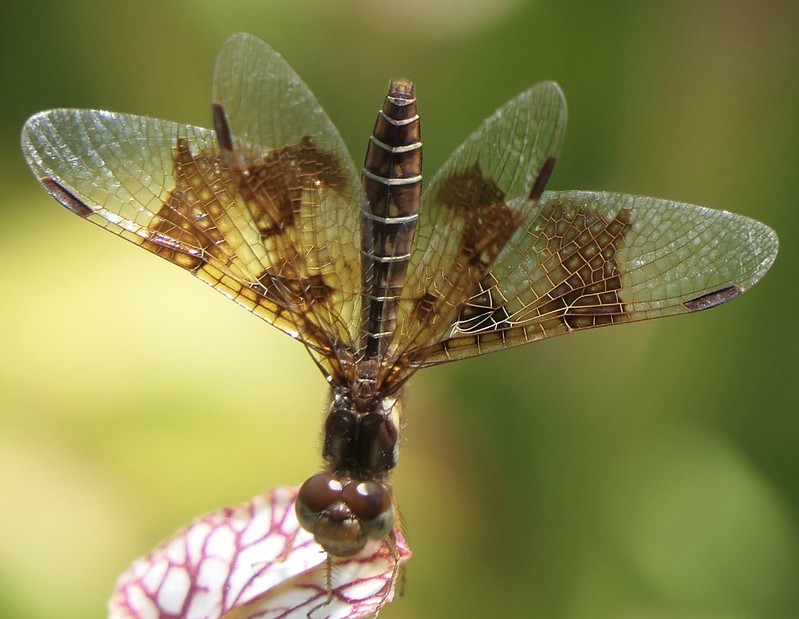     These guys are super shy, about 8 feet away 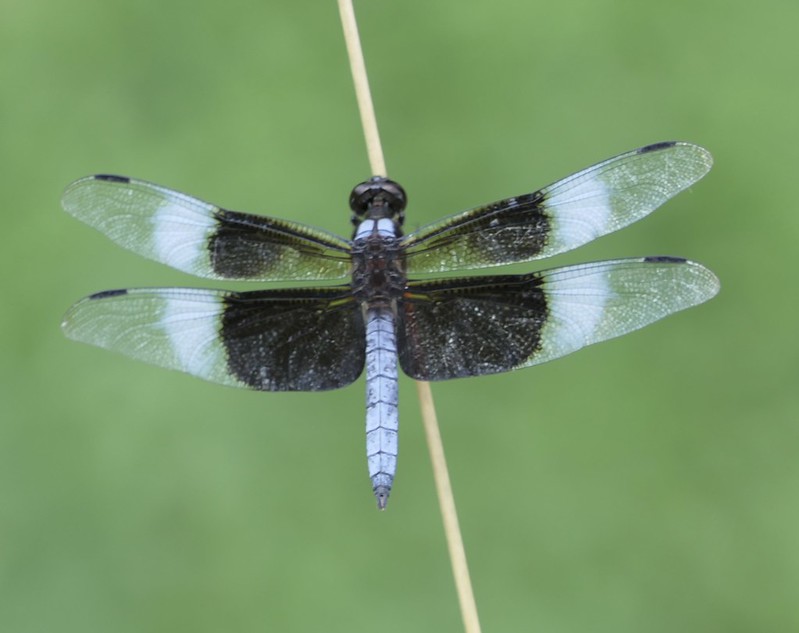 |
|
jamesp
Cave Dweller 
Member since October 2012
Posts: 36,602
|
Post by jamesp on Jul 29, 2022 6:09:10 GMT -5
Other varieties. The blue one is the dominator. They rule the area. Maybe someone knows why they stick there southbound end straight up in the air. Impaling parachuters ? It's called Obelisking. It's thought it is a way to regulate body temp. The Blue Dashers do that quite often. Nice shots! Nice variety: Slaty Skimmer, Eastern Amberwing, Blue Dasher and Widow Skimmer.       These guys are super shy, about 8 feet away  Thanks much for the ID rob7789. There are so many varieties to sort thru to ID them. It makes sense they are obelisking this year since it has been real hot. I had a career in wetland mitigation and always noticed dragonfly larvae could survive in the most polluted of waters - note Blue dasher. Thanks again, I wanted to know their ID. There are quite a few other variations on site, just can't get photos due to their shyness.(I'll keep trying !) Widow skimmer  Blue dasher(very common, larvae stage resilient to polluted water)  Eastern amberwing(mimics a wasp for protection from predators) 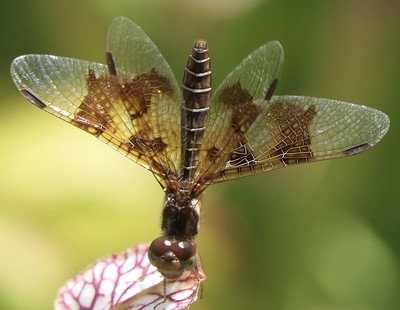 Slaty skimmer 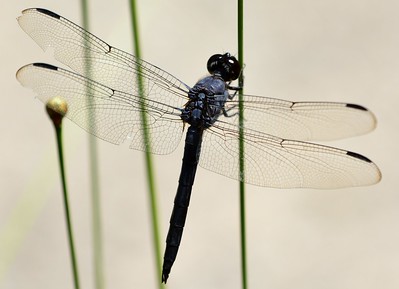 |
|
jamesp
Cave Dweller 
Member since October 2012
Posts: 36,602
|
Post by jamesp on Jul 29, 2022 9:20:52 GMT -5
Probably a female Eastern pondhawk(my fav so far). The males are almost all blue. rob7789 ?  |
|